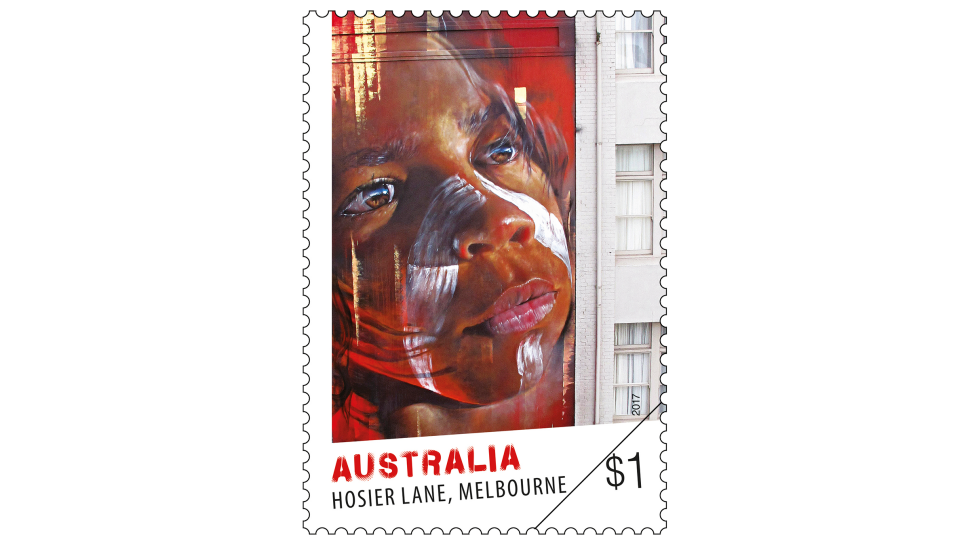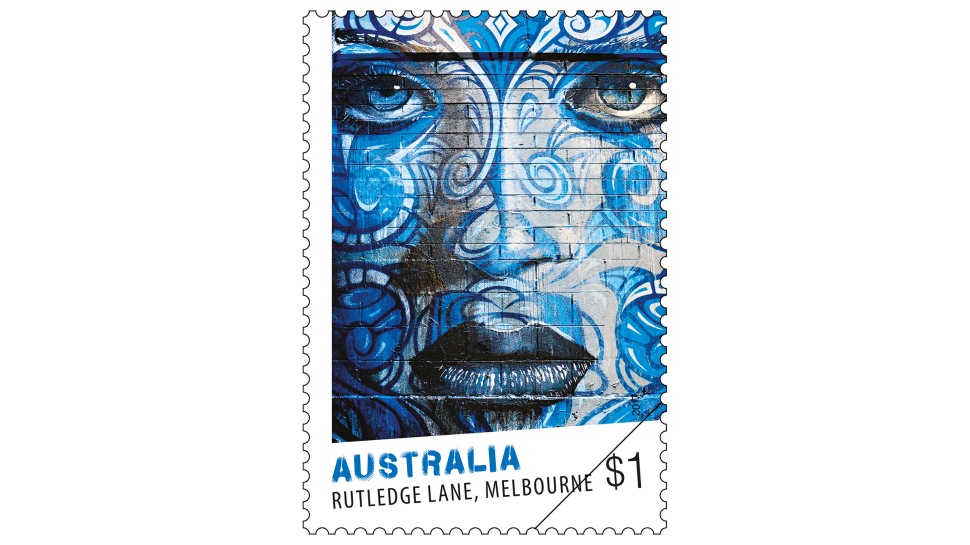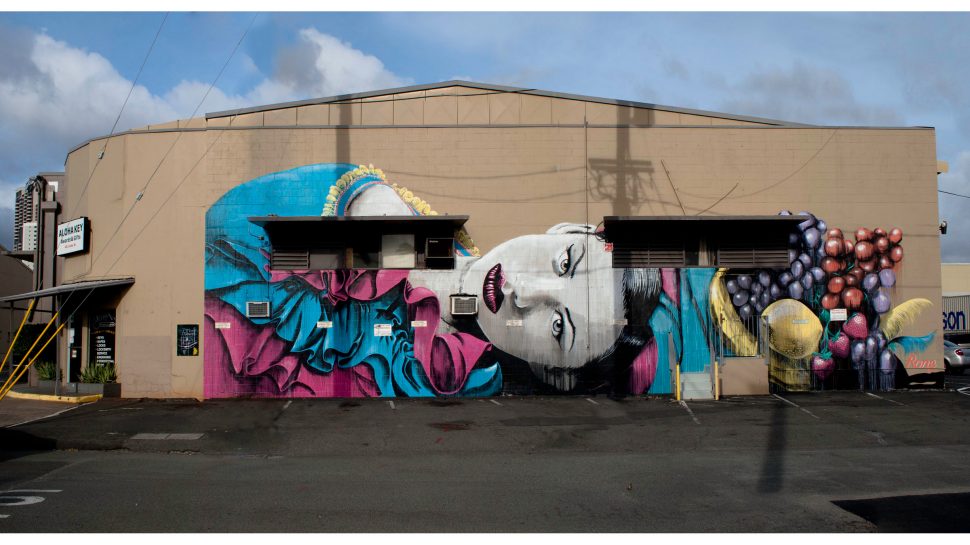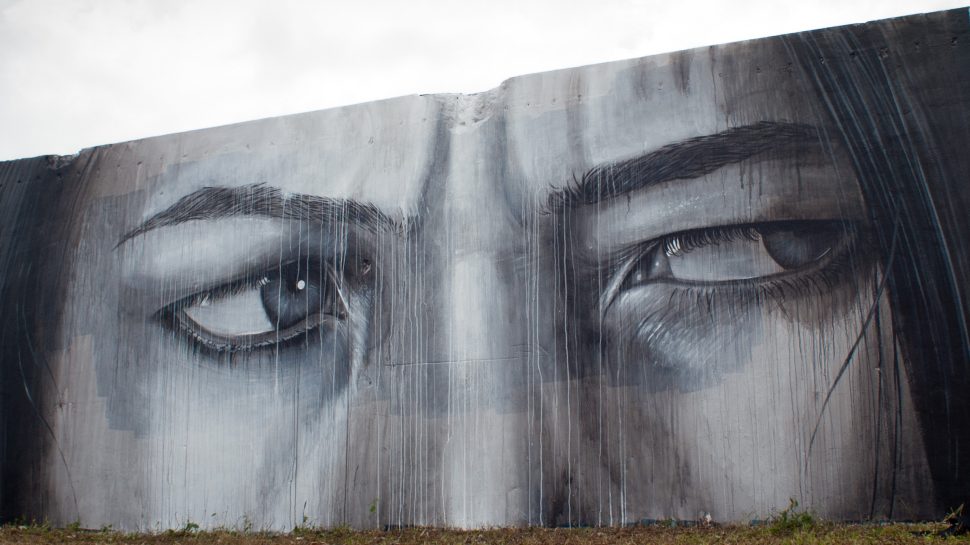In recent decades there has been an explosion of art practice in our urban environments. Street art describes public artistic expression that appears outside traditional art venues, such as galleries.
Beginning as unsanctioned graffiti in the 1980s, street art has now evolved into a sophisticated range of practices, including stencil art, poster art, spray painting, yarn bombing and installation art.
Australia has a particularly vibrant street art culture. In fact, street art is now a celebrated aspect of many urban Australian environments. For some cities, street art has even become a tourist attraction, and (perhaps ironically given its origins) a way of transforming an area and making it more attractive for the local community.
The Street Art stamp issue, released on 16 May 2017, features four portraits by internationally respected artists painted in the streets of Melbourne and Adelaide.
Adnate is a high profile Melbourne artist whose large scale, photo-realistic works can be seen all over the world. Commissioned by the City of Melbourne, his 23 metre mural of an Indigenous boy was painted in Hosier Lane, Melbourne, in 2014. As in this portrait, Adnate’s subjects are often members of Indigenous communities, and the artist has done a significant amount of fundraising work in this area, addition to the attention he draws through his artwork. Adnate has listed renaissance portrait painters such as Caravaggio as influences.
Influential Adelaide-based artist Vans the Omega painted this vivid female portrait in Railway Terrace, Adelaide in 2015. Vans the Omega has travelled the world for more than two decades, creating and painting murals featuring letterforms, shapes and patterns, as well as portraits. His stated influences are many varied, ranging from ancient scripts and architecture to the concepts of movement and balance.
Irish-born, London-based urban artist Fin DAC employed a stencil and spray paint technique to create the mural Shinka, as part of the Little Rundle Street Art Project in Adelaide, in early 2016. Fin DAC specialises in large scale portraits, often of women in masks. In Shinka we can see his characteristic technique of mixing traditional cultural dress with western fashion, as well as black and white forms that are punctuated with vivid splashes of colour.
Australian artists Rone and Phibs collaborated on Forever curious, the expressive portrait of a woman in Rutledge Lane, Melbourne in June 2013. As is the transient nature of much street art, it was painted over with blue paint by another artist only two months later.
Phibs is a highly respected name in the Australian street art scene. His works are on display in Melbourne (particularly Fitzroy) and Sydney as well as around the world. Phibs has concurrently entered the world of ‘fine art’, with several of his works being acquired by the National Gallery of Australia.
We spoke to Rone about his path into street art and what inspires him.
“I grew up in a country area the far side of Geelong, I was always interested in art, but I studied Design as I thought it was a better career path. When I moved to Melbourne to study Graphic Arts, I was inspired by seeing works of other artists who were making stencils around the city,” says Rone.
Rone’s street art began with making stencils for skateboards and skate parks, but he soon branched out to the laneways of Melbourne and then beyond. His evocative works, usually involving enormous murals of haunting female faces, seek to show that beauty can be a fleeting thing. His striking juxtapositions of beautiful faces and decaying buildings can be found on the streets of Melbourne, New York, Paris and Tokyo, as well as London, Christchurch, Santo Domingo and Port Villa.
Yet his success as a street artist has also led to national and international gallery exhibitions, acquisitions and commissions, including by the National Gallery of Victoria, Stolen Space in London, White Walls in San Francisco, Urban Nation in Berlin, and Opera Gallery in New York. While he works all over the world, Rone is based in Melbourne, working as part of Everfresh Studio.
How does Rone achieve such large-scale works? “I use a scissor lift or ladder, brushes, rollers and extension poles. Like anything, it’s just about using the right tool for the job,” he says.
While Rone is no doubt an inspiration to up-and-coming young artists on the scene, he too has admired many artists along the way, from graffiti artists of the 1980s and 1990s, largely unknown to the general population, to renowned Australian contemporary painter and installation artist Anthony Lister.
“Anthony Lister is an Australian artist I always credit with leading the way for so many other artists like myself to be recognised. He was recognised as an artist long before ‘street art’ was generally accepted,” says Rone.
The artwork on the stamp, by Rone and fellow artist Phibs, was painted in Melbourne. When asked why Melbourne has such a strong and vibrant street art culture, Rone said: “The laneways give plenty of opportunities to find a place to paint and the city has a relaxed graffiti removal program compared to the zero-tolerance that artists of other cities face.”
Rone felt “pretty excited and honoured” to have his and Phib’s artwork featured on a postage stamp.
“The artwork in particular was actually commissioned by The Age newspaper as part of a campaign about exploring the city of Melbourne, so it was intentionally hidden down the end of a laneway.
It was based on a collaboration that Phibs and I had done in the past. Phibs and I have shared a studio space for about a decade, before he moved back to Sydney, so it’s nice to work together when we get the chance,” said Rone.
Expressive female motifs are a regular theme in Rone’s work. The women in his work are real people – models who Rone works with to create the reference images used for his large-scale works.
“My work is about trying to find the balance point between beauty and decay, so my ideal situation is to make an ugly wall a thing of beauty, whilst retaining the original character of the wall,” says Rone.
The Street Art stamp issue is available from 16 May 2017, online, at participating Post Offices and via mail order on 1800 331 794, while stocks last.
View the gallery of stamps and technical details for this issue.
The additional artwork featured in the article and banner are by Rone.
This article was produced at the time of publication and will not be updated.







